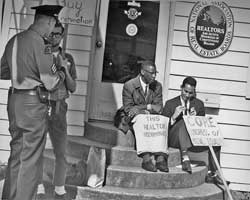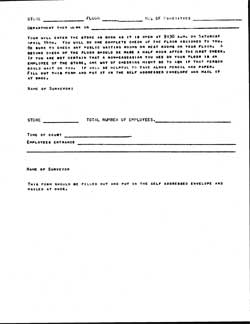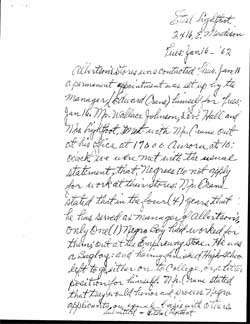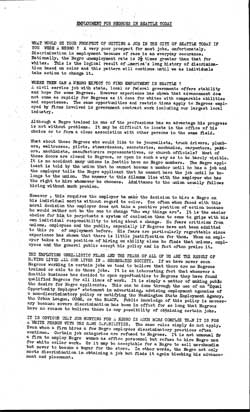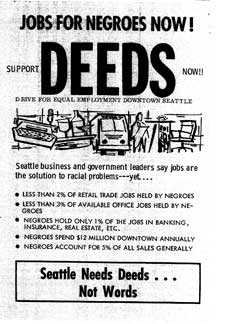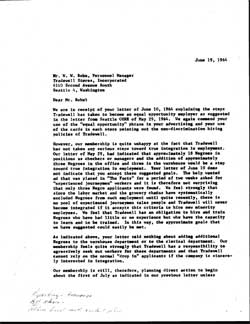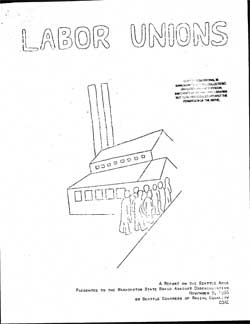The Congress of Racial Equality, or CORE, was a national civil rights organization founded in 1942 to challenge segregation and racial discrimination in northern cities. CORE’s local chapters took up a number of campaigns around civil rights issues, and in Seattle, one CORE’s main goals during the 1960s was to address the problem of rampant employment discrimination. By determined monitoring of the hiring and firing practices of employers and with threats of boycott action, CORE was able to address and bring to light racial discrimination within Seattle-area business and labor unions.
Once CORE determined that a specific company was discriminatory in its employment practices, usually discerned by taking surveys and reading letters of complaint, a negotiating process would be initiated. CORE’s main tactic was direct negotiation with the employer that had been identified as discriminatory. CORE’s negotiating team was “always integrated,” and usually consisted of three people, sometimes four. The team would ensure that they were meeting with the top management of the discriminatory business or company.1
The negotiators would begin by informing the employer of the seriousness of discrimination and explain why the employer should immediately move to address the problem. CORE urged the employer to use the phrase “Equal Opportunity Employer” in their employment notices and advertising to hire more African-Americans, and to promote existing African-American employees. CORE did not ask employers to fire other employees “in order to accomplish integration.”2 Rather, their negotiations focused on expanding full-time employment and non-menial job opportunities for African-Americans. CORE requested that the employer furnish them with a list of its white and non-white employees, an index of the type of positions held, and the number of full- and part-time positions available at each company in order to measure progress (or the lack thereof) after the negotiation process was completed. The negotiators would then give this information, along with their notes, to the general membership and Executive Board of CORE before any decisions were made to escalate their tactics.
Multiple negotiations sometimes took place before the employer and CORE could come to an agreement. If the employer failed to make meaningful progress in terms of hiring more African-Americans, CORE would send a letter notifying the employer that they were considering a boycott of the company. One of the most notable boycott campaigns conducted by CORE in Seattle was the Drive For Equal Employment in Downtown Stores (DEEDS) in 1964.3 Since most employers wanted to avoid boycotts and eventually capitulated, CORE was very successful in its tactics of direct negotiation and threats of boycott.
CORE collected statistics and figures proving that discrimination in Washington State hiring practices existed. A striking example is the 1964 “Survey of Non-white Employees in State Government,” undertaken by the Washington State Board Against Discrimination, which was created in the 1940s as part of the Fair Employment Practices Act.4 Table I, titled “Non-white Employees by State Agency,” shows that of a total of 19,495 employees within 45 state agencies, only 251 are non-white. Further, the survey indicates, “Twenty-five, or 55% of the Departments show an all-white employment pattern.”5 Table II, titled “Non-white Census–Department of Institutions” lists 5,951 total employees of which only 134 were African-American. In assessing both tables, the report stated “there are 418 non-white employees among the total of 19,495 reported. This represents a 2% over-all non-white pattern.”6 Further, the report noted that when African-Americans were counted alone, that is, without other minorities, they comprised only 1% of the total employees.
Table III, listing the “Occupation Composition of Non-white Employees of the State,” illustrates the disparity that existed in the types of jobs afforded to African-Americans.7 According to the survey, African-Americans were concentrated in menial positions such as janitorial, maintenance, and housekeeping work. Jobs that African-Americans were less likely to have were:
“police, probation officers, safety inspectors, liquor store managers, psychiatric school workers, claims investigators, psychiatric nurse, assistant attorney general, cadet teacher, member of parole board, executive secretary, examiner, auditor, sr. associate bridge engineer, member youth development corps, barber, baker, engineering technician, and hydrotherapist.”8
It is unclear how CORE interpreted and used all of this data; however, given their tenacity, it is likely that they addressed this issue in some way, and that they targeted specific companies after learning of repeated complaints by employees.
The types of complaints that CORE received from employees were familiar in their patterns of discrimination. For example, a 1966 letter regarding a Mr. John Cornethan stated that he had answered an Equal Opportunity advertisement for the position of maintenance electrician, calling for either experienced or un-experienced men. Upon meeting the shop foreman, Mr. Cornethan assured him of his extensive experience as an electrician. However, the foreman told Mr. Cornethan that the application was too complicated to fill out and that he should just leave his name and telephone number. The foreman also indicated that the position had been filled, asking Mr. Cornethan, “what else can you do?” After one week, though, the advertisement reappeared and ran for at least another week, still advertising the position with an “Equal Opportunity Employer” claim. CORE concluded their investigation by stating that “not one non-white [was] visible in [the] entire plant.”9
Another 1966 letter stated that a Mr. Gamble had applied for the position of plastics assembler at Honeywell Seattle Development Lab, with a background of over nine years of experience in plastics. At the time of his application, the position was open, and Mr. Gamble was told that his qualifications were in order and that he would be contacted soon. After he didn’t hear from Honeywell, he called back to find that the position had been filled. Mr. Gamble said that he was told he “wouldn’t fit in.” Subsequently, he was offered a position as a janitor. CORE determined that the Honeywell Development Lab had “no Negro clerical, technical, or professional employee on [their] entire staff of over 325 employees.” As CORE remarked, “There seems to be evidence of a definite pattern of discrimination.”10
A 1966 CORE letter regarding the Tradewell grocery branch on Rainier Avenue South and South McClellan Street gives an account of a man being fired because of his race. Mr. James Diamond was fired from his job after the assistant manager had made some clearly racist remarks to him, stating “I’m going to talk to the manager and fire you.” Further, he threatened, “I’ll give you a reason for going to C.O.R.E. and the NAACP.” The managers used the excuse of a bounced check that Mr. Diamond had written to fire him, even though other employees were retained who had a similar situation. Mr. Diamond was to get a raise soon, and felt he had been fired because of discrimination. The CORE letter reported on the general discriminatory culture of the workplace, writing that “throughout the store Negroes are frequently and jokingly called ‘Nigs’ and the Japanese man is called ‘Buddha.’” 11[](CORE_employerdis.htm#_edn11) In this instance, CORE intervened and was able to help Mr. Diamond get his job back.
This incident happened in 1966, two years after CORE had staged a boycott of the Tradewell stores, which indicates that Tradewell was intransigent in changing its discriminatory hiring practices. A flyer advocating the 1964 boycott stated:
260 full-time employees in stores, only 6 Negro clerks
115 full-time in offices and warehouse, only 2 Negroes
No Negro truck drivers
No Negroes in the office
18 greater Seattle area stores, Negro employees restricted to 2 Central Area stores…Seattle CORE has been negotiating with Tradewell for over 2 years! CORE knows of qualified ‘Negro Applicants’ who have applied at Tradewell and HaveNot Been Hired when openings were available.12[](CORE_employerdis.htm#_edn12)
The flyer states that CORE had been negotiating with Tradewell for over two years, which means that the incident with Mr. Diamond happened at least four years after CORE began negotiating with Tradewell. This suggests that CORE was both patient and diligent in their negotiating procedures, but was also willing to proceed with a boycott when its demands were not met within a reasonable time frame.
Tradewell was not the only grocer that CORE identified as discriminatory with respect to hiring practices. Seattle’s Safeway markets, according to CORE, discriminated in hiring practices, concentrated African-American employees in areas of Seattle that had a higher percentage of African-American residents, and relegated African-Americans to lower-paying and lower-status jobs.13 After an investigation of Safeway in 1961, CORE advised minorities to submit applications, prompting eight qualified African-Americans to do so. After the eight were refused a position, CORE conducted a survey to determine the following:
Had Safeway been hiring in the last four weeks?
If so, had Safeway hired Negroes or other minority persons unknown to the NAACP and CORE?
How near to their jobs do Safeway employees typically live?14[](CORE_employerdis.htm#_edn14)
The survey collected information from 25 of Safeway’s 38 Seattle stores. CORE discovered that only 1% of employees in these stores were African-American, and that of this 1%, all non-white employees except for one were concentrated in the Central District, Seattle’s historically African-American neighborhood.
Mr. Lee, a representative for Safeway denied a pattern of discrimination and claimed that the reason African-Americans were concentrated in certain areas was because it was Safeway’s policy to keep employees at stores near their residences. The survey, however, found that this was not the case. The CORE document states, “In fact, district hiring appears to exist only on paper in the personnel office. Its only real effect is to prevent Negroes from working outside the Central district.”15 A description of another survey for Lucky Grocery Stores is similar to that of the Safeway survey. Of 126 employees counted in 13 stores, only 6 were African American, and they were concentrated in two stores.16 These kind of investigative techniques were important, as they allowed CORE to measure the extent of the problem in a particular company, to measure a company’s progress over time, and to factually demonstrate whether an employer was fulfilling its claims of being an equal opportunity employer.
Five years after the Safeway investigation, in 1966, a Mrs. Ethel Torrey was fired from her position as a checker at Safeway “rather vaguely.” Mrs. Torrey believed that she was fired because of her race and not for the reasons cited by management. Further, Mrs. Torrey was not informed of any supposed performance issues before she was let go. When Mrs. Torrey contacted the Retail Clerks’ Union Local #1105 to complain, the business agent informed her that there had been other complaints about her store. Mrs. Torrey also filed a complaint with the Washington State Board Against Discrimination.17
CORE investigated discriminatory practices in other businesses as well. In 1964, CORE boycotted Farwest Cab Company and Gray Top Cab Company for their discriminatory hiring practices. The CORE document on the boycott states that Farwest Cab Company and Gray Top Cab Company, “totaling 380 drivers, do not now and never have had a Negro driver and have no present plans for [hiring] such drivers. They have collective bargaining agreements with a labor union.”18 Two letters of complaint from a Miss Justine Sires were addressed to Farwest Cab Company and Gray Top Cab Company. The first states:
It has recently been drawn to my attention that Farwest does not employ Negro drivers. I was surprised and disappointed with this information. Since I am unwilling to support a business which practices discrimination in hiring, I will no longer use Farwest cabs. I am in the process of notifying all of my friends and acquaintances of your discriminatory policy, so that they can patronize another company—one which does hire Negroes.19[](CORE_employerdis.htm#_edn19)
The second letter reads almost identically.
Employer-based discrimination in private businesses was a key focus for CORE, but it is clear that CORE was also concerned with discrimination in trade unions. A survey from 1965 listed fifteen different building and trade unions. Only eight of these unions had African-American members and even then, in extremely small numbers (one to two). Only three of these unions admitted African-American apprentices, again is small numbers, and only one admitted an African-American journeyman.20 It is very possible that Farwest and Gray Top Cab companies had collective bargaining agreements with discriminatory trade unions, thus creating a double barrier to employment for African-Americans.
As we have seen, with the collection of data through surveys and investigations, CORE was able to determine if, and to what extent, discrimination existed with respect to employment practices, both within private businesses and labor union structures. Additionally, CORE received letters of complaint from victims of discrimination, and if the situation warranted, CORE would intervene on the victim’s behalf. If CORE determined that discrimination was evident, CORE would contact the employer in the hope of engaging in a negotiating session, requesting and analyzing minority employment figures for that employer as a means to measure any future progress. If, given a reasonable amount of time, an employer failed to make significant progress, CORE would threaten a boycott. CORE’s persistence in tracing employee complaints and in monitoring employers and labor unions exposed discriminatory employment practices in Seattle and contributed significantly to a great public awareness regarding institutionalized racial discrimination.
Copyright © 2008 Jamie Brown
HSTAA 353 Spring 2008
1 Summaries of Reports on Past and Current Negotiations, January 1964, “Some General Goals and Principles of CORE Negotiations,” Accession 1563-1, University of Washington Libraries, Special Collection Division, Box 3, folder Committees Negotiating Committee.
2 Ibid.
3 “Seattle Civil Rights and Labor History Project.” October 1, 2007. organizations.htm#core (accessed May 24, 2008).
4 Washington State Board Against Discrimination: Survey of Non-white Employees in State Government, January 1, 1964, CORE Collection, Accession 1563-1, University of Washington Libraries, Special Collection Division, Box 6, Folder Employment DEEDS Ephemera.
5 Ibid., 2.
6 Ibid., 3.
7 Ibid., 4.
8 Ibid., 4.
9 Letter regarding Washington Iron Works, September 28, 1966, CORE Collection, Accession 1563-1, University of Washington Libraries, Special Collection Division, Box 8, Folder Discrimination Complaints.
10 Letter regarding Honeywell Seattle Development Lab, July 6, 1966, CORE Collection, Accession 1563-1, University of Washington Libraries, Special Collection Division, Box 8, Folder Discrimination Complaints.
11 Letter regarding Tradewell Store # 5, March 16, 1966, CORE Collection, Accession 1563-1, University of Washington Libraries, Special Collection Division, Box 8, Folder Discrimination Complaints.
12 Flyer advocating boycott of Tradewell Stores Inc., July 11, 1964 (written in pencil on flyer), CORE Collection, Accession 1563-1, University of Washington Libraries, Special Collection Division, Box 8, Folder Tradewell Stores Inc. Clippings and Ephemera.
13 Letter from CORE, October 27, 1961, CORE Collection, Accession 1563-1, University of Washington Libraries, Special Collection Division, Box 8, Folder Safeway, Minutes, Reports.
14 Ibid.
15 Ibid.
16 Survey of Seattle Lucky and Foodland Grocery Stores, August 19, 1963, CORE Collection, Accession 1563-1, University of Washington Libraries, Special Collection Division, Box 8, Folder Lucky Grocery Stores.
17 Letter, April 12, 1966, CORE Collection, Accession 1563-1, University of Washington Libraries, Special Collections Division, Box 8, Folder Discrimination Complaints.
18 Letter, “Boycott of Named Taxicab Services,” August, 1964, CORE Collection, Accession 1563-1, University of Washington Libraries, Special Collection Division, Box 8, Folder Taxi Service Out 1963-1964.
19 Ibid.
20 Non-white Participation in the Building and Trade Unions—Seattle, October/November 1965, CORE Collection, Accession 1563-1, University of Washington Libraries, Special Collection Division, Box 6, Folder Employment Ephemera.

